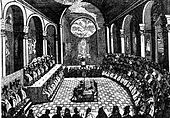| Council of Ephesus | |
|---|---|
 Image in the church Notre-Dame de Fourvières, France. The priest standing right in the middle is Cyril of Alexandria. On the throne is the Virgin Mary and child Jesus. | |
| Date | 22 June – 31 July 431 |
| Accepted by | |
Previous council | First Council of Constantinople |
Next council |
|
| Convoked by | Emperor Theodosius II |
| President | Cyril of Alexandria |
| Attendance | 200–250 (papal representatives arrived late) |
| Topics | Nestorianism, Theotokos, Pelagianism |
Documents and statements | Confirmation of the original Nicene Creed, condemnations of heresies, declaration of Mary as "Theotokos", eight canons |
| Chronological list of ecumenical councils | |
| Part of a series on the |
| Eastern Orthodox Church |
|---|
| Overview |
| Part of a series on |
| Oriental Orthodoxy |
|---|
 |
| Oriental Orthodox churches |
|
|
| Part of a series on the |
| Ecumenical councils of the Catholic Church |
|---|
 |
| 4th–5th centuries |
| 6th–9th centuries |
| 12th–14th centuries |
| 15th–16th centuries |
| 19th–20th centuries |
|
|
The Council of Ephesus was a council of Christian bishops convened in Ephesus (near present-day Selçuk in Turkey) in AD 431 by the Roman Emperor Theodosius II. This third ecumenical council, an effort to attain consensus in the church through an assembly representing all of Christendom,[2] confirmed the original Nicene Creed,[3] and condemned the teachings of Nestorius, Patriarch of Constantinople, who held that the Virgin Mary may be called the Christotokos, "Christ-bearer" but not the Theotokos, "God-bearer". It met from 22 June to 31 July 431 at the Church of Mary in Ephesus in Anatolia.
- ^ Olson, Roger E. (1 April 1999). The Story of Christian Theology: Twenty Centuries of Tradition Reform. InterVarsity Press. p. 158. ISBN 978-0-8308-1505-0.
- ^ Richard Kieckhefer (1989). "Papacy". Dictionary of the Middle Ages. ISBN 978-0-684-18275-9.
- ^ [clarification needed]
- Schaff, Philip; Wace, Henry, eds. (1996) [1890], A select library of Nicene and post-Nicene fathers of the Christian church, Second series, vol. VII, Grand Rapids, Michigan, MI: Wm. B. Eerdmans, ISBN 0-8028-8121-1 – via Internet Archive
- Schaff, Philip; Wace, Henry, eds. (1890–1900), A select library of Nicene and post-Nicene fathers of the Christian church, Second Series, vol. 14, The Seven Ecumenical Councils, New York: Christian Literature Co. – via Internet Archive
- Schaff, Philip; Wace, Henry, eds. (1890), "Early Church Fathers: Nicene and Post-Nicene Fathers", The Tertullian Project, II